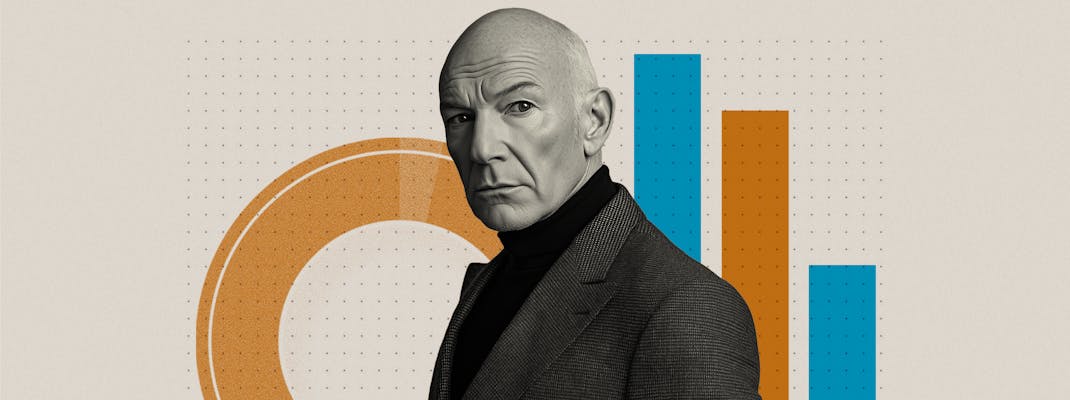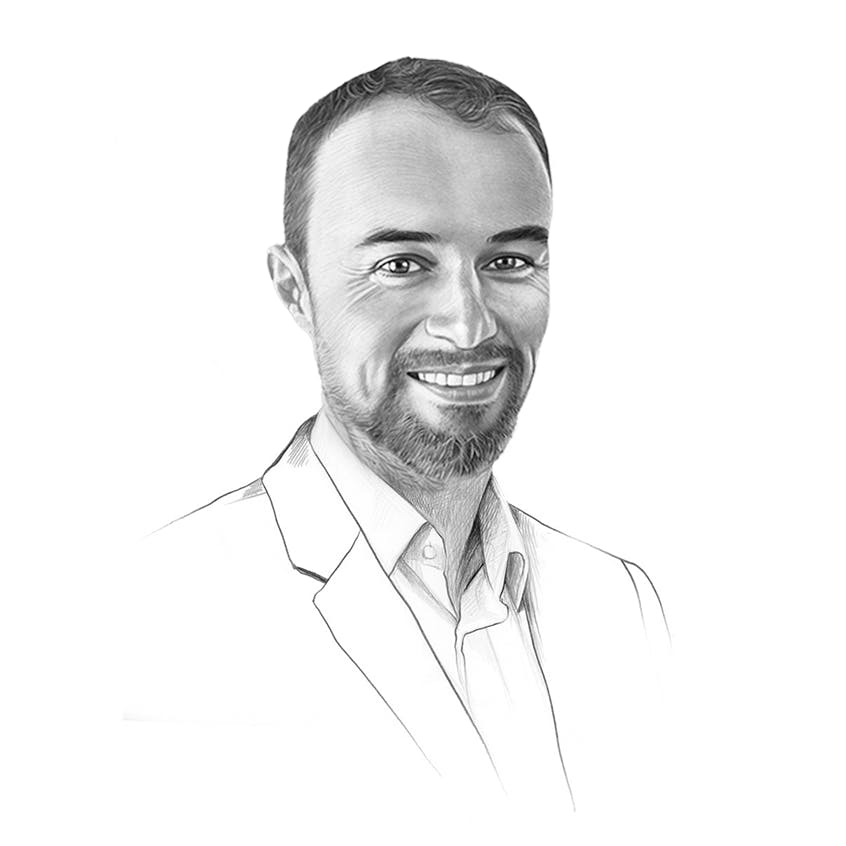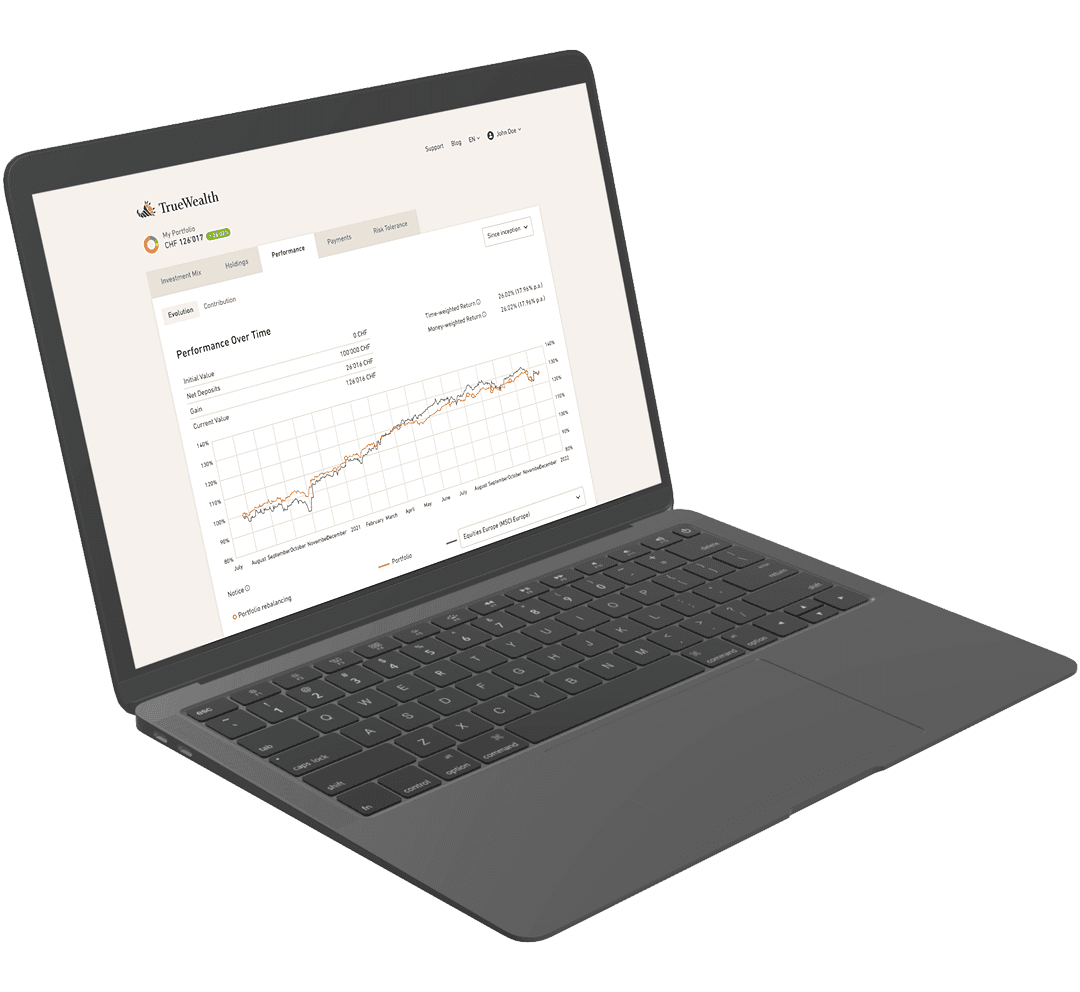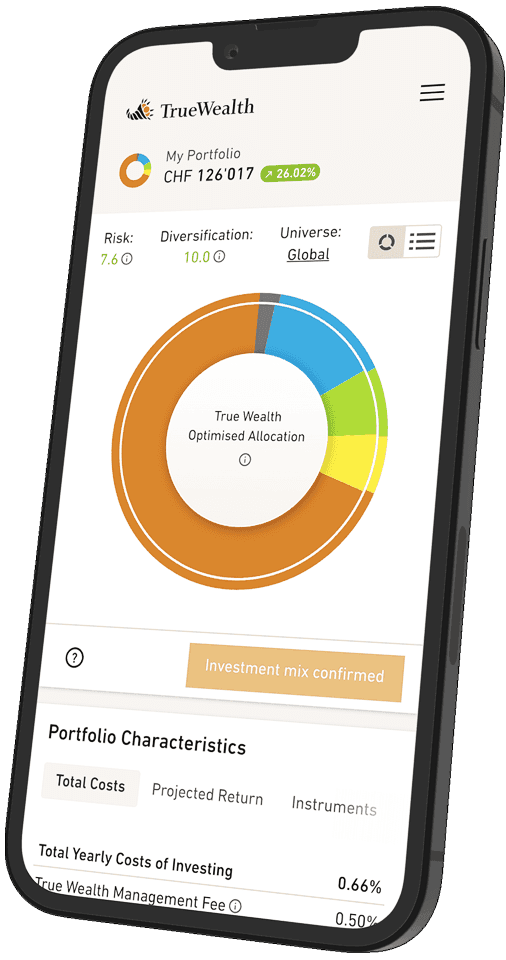
Several accounts, one strategy: With a clear focus to investment success.
The optimal portfolio needs investments in multiple asset classes. But only one investment strategy. Read here why a holistic strategy is better.
A single, well-designed investment strategy in a well-diversified portfolio: This is the most effective way to grow your wealth over the long term. That's why, at True Wealth, we rely on a single strategy for investing of free assets as well as pillar 3a, even if the assets in the third pillar have to be held in a different account.
Traditionally, the different accounts are also invested with different strategies. However, there is no scientific consensus that this approach is actually superior. Rather the opposite.
We present your assets in a uniform user interface. This is more transparent. We take you through the risk profiling questions only once for all parts of the portfolio. That's more convenient. And under the hood, we use the same algorithms to automatically implement your investment strategy - for optimal diversification.
More convenient and transparent – with the best possible diversification: the advantages are obvious. The path to a holistic portfolio could therefore soon be taken by some providers. For now, we at True Wealth are pioneers. And so our approach is still unfamiliar to many, and there are reservations.
Let's do the math.
Imagine you inherit a million francs and pursue two different investment goals with that million:
Investment goal 1: Repay mortgage. You have a mortgage of 820'000 Swiss francs and would like to be able to repay it in 25 years in any case. During this time, you pay the mortgage interest from your earned income, because you want to be employed for at least that long.
Investment goal 2: Enjoy life in retirement. Enjoy life with your remaining assets and perhaps even retire early. For this goal, you are willing to take on a little more risk.
Assume 25-year government bonds are yielding 2 percent and you expect a long-term return of 5 percent per year on stocks. Both after taxes.
The obvious solution would be to mentally split your assets in two.
For investment goal 1, you want to play it safe: You discount the CHF 820'000 at 2 percent, the result is CHF 500,000. Consequently, you form portfolio A with CHF 500'000 and invest it in Swiss government bonds. After 25 years at 2 percent per year, the result is CHF 820'000.
For investment goal 2, you invest the other 500'000 francs in portfolio B. Here, your risk tolerance is higher and you therefore invest everything in equities. With an expected 5 percent return, this will result in a sum of 1'693'000 for your early retirement after 25 years.
Both portfolios do not achieve a bad result. In their sum, assets of 2'513'000 are created.
However, a holistic approach would be even better.
With an investment horizon of 25 years, you could also invest the entire inheritance globally diversified in equities. The probability that the investment result will be less than 820'000 Swiss francs and thus insufficient to repay the mortgage is extremely low – historically, such loss periods have hardly lasted longer than 15 years. (See also: Drawdown: How Much Can You Afford To Lose?) From the holistic portfolio with shares, you can expect an assumed return of 5% at the end of 3'386'000 francs. That's 873'000 francs more than the 2'513'000 francs from the separate portfolios – a full 35 percent more. So the holistic portfolio strategy can help you make the best use of your risk budget.
Let's not misunderstand each other: There is never absolute certainty in investing; even with an investment horizon of 25 years, a negative result is very unlikely, but not completely ruled out.
Mental accounting: Our brain loves separate portfolios
So a single portfolio can do more than separate portfolios. But why do people still like to split their portfolios?
The reasons lie in human perception. The economic discipline of behavioral economics calls it mental accounting. And from that point of view, they almost can't be called reasons – rationally speaking. They are the emotional stories we tell ourselves and use to justify the allocation of portfolios.
These are the two arguments most often cited:
Diversification: dividing a portfolio by investing in different asset classes, such as stocks, bonds, real estate and cash, can help reduce overall risk. So far, the argument is true. But some investors are misled by this into thinking they should also diversify between portfolios, not just between asset classes. They are looking for perceived diversification. The best diversification, however, can be achieved primarily with a single, combined portfolio. And not just at the beginning of the investment period. But also with each subsequent deposit. And with rule-based rebalancing that keeps portfolio composition and risk on track.
Two other arguments are also often put forward as reasons. Both are valid to a certain extent. Let's take a closer look at "tax-efficient investing" and "different investment objectives".
Tax-efficient investing: No more need for splitting
Keeping several different accounts can help save on taxes. Tax-privileged Pillar 3a investments belong in a different account than securities and cash holdings in free assets. Legally, there is no way around this fact in Switzerland.
However, this does not mean that these different accounts must also be managed as different portfolios. Traditionally, this is often the case – and most 3a providers push their clients into expensive fund products that cannot be customized. In the past, the strategy even had to be separate: Until 2012, the maximum equity allocation allowed in retirement plans was 50 percent. Anyone who wanted more than 50 percent in equities in their free assets had to think of their portfolios separately in any case.
More recent regulations make it possible to apply the same investment strategy to the entire portfolio, even if the investments are legally held in separate custody accounts.
Different investment objectives, different time horizons?
Many investors run a different portfolio for each investment objective. Their argument: their investment goals are on different time horizons. They won't need the assets they're building for retirement for another 25 years. The provision for their children's studies will be due in ten years. And the down payment on the home could be needed in five years.
With these different goals in mind, investors then go in and design different portfolios for the different time horizons. Normally, the closer to the planned date of expenditure, the more risk-averse they behave. Anyone acting according to this maxim would have to invest the equity for the house or apartment very conservatively and would hardly be allowed to bet on shares.
But who says that the purchase of a home will really take place in five years, and not before or later? And who says that for the equity of the owner-occupied home not yet also the old-age pension is drawn, already before expiration of the entire investment period? The law provides for many exceptions to withdraw capital from pillar 3a before retirement – but actually a horizon of 30 years was planned for retirement provision.
Life is uncertain. Long-term forecasts about one's personal situation are fraught with great uncertainty and are therefore often off the mark. That is why we at True Wealth are convinced that all these supposedly different investment objectives ultimately all have one and the same goal: To grow your wealth in the best possible way. As long as the goals are your own goals, then there are no different target horizons – there is only one investment horizon per person.
Risk profiling: one strategy, one questionnaire
Every wealth manager will create a risk profile for each client, and in Switzerland they are required to do so by law. This risk profile forms the basis for all investment decisions. For example, the risk capacity and risk tolerance and the investment horizon are determined – and the individual weighting of asset classes is made on this basis.
The risk profile of each portfolio is determined not only by the objectives for that portfolio. It is also always determined by the customer's situation. If the economic situation changes – for example, if the customer retires or reduces his workload – then the risk profile must change. And this applies to all of his portfolios.
Any wealth manager who does his job thoroughly has to follow up on this. That's why we regularly send you questions again for an update. If you answer a question differently than before, we adjust your portfolio. That's the end of the matter for you. If you have multiple portfolios, the work really starts – but we'll be happy to save you that effort.
A single investment strategy: even across multiple accounts
On the surface, there seem to be good arguments for splitting portfolios. However, on closer inspection, most of them turn out to be less than rational. All the good intentions of mental accounting can be accomplished just as well with a single portfolio – with a better balance of risk and return.
With True Wealth, your assets may legally be in different accounts at the custodian banks, but you get a holistic, customized portfolio: that's more convenient and transparent – with the best possible diversification. And with a clear focus: your investment success.
About the author

Founder and CEO of True Wealth. After graduating from the Swiss Federal Institute of Technology (ETH) as a physicist, Felix first spent several years in Swiss industry and then four years with a major reinsurance company in portfolio management and risk modeling.

Ready to invest?
Open accountNot sure how to start? Open a test account and upgrade to a full account later.
Open test account